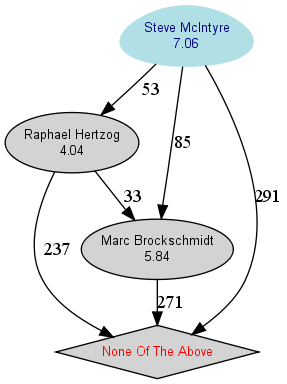Debian Project Leader Elections 2008
Time Line
| Nomination period: | March 2nd 00:00:01 UTC, 2008 | March 9th 00:00:00 UTC, 2008 |
|---|---|---|
| Campaigning period: | March 9th 00:00:01 UTC, 2008 | March 30th 00:00:00 UTC, 2008 |
| Voting period: | March 30th, 00:00:01 UTC, 2008 | April 13th, 00:00:00 UTC, 2008 |
Please note that the new term for the project leader shall start on April 17th, 2008.
Nominations
- Marc Brockschmidt [he@debian.org] [platform]
- Raphaël Hertzog [hertzog@debian.org] [platform]
- Steve McIntyre [93sam@debian.org] [platform]
The ballot, when ready, can be requested through email by emailing ballot@vote.debian.org with the subject leader2008.
Debate
Don Armstrong and MJ Ray have volunteered to be debate moderators.
Data and Statistics
This year, like always, statistics will be gathered about ballots received and acknowledgements sent periodically during the voting period. Additionally, the list of voters will be recorded. Also, the tally sheet will also be made available to be viewed. Please remember that the project leader election has a secret ballot, so the tally sheet will be produced with the hash of the alias of the voter rather than the name; the alias shall be sent to the corresponding voter along with the acknowledgement of the ballot so that people may verify that their votes were correctly tabulated. While the voting is open the tally will be a dummy one; after the vote, the final tally sheet will be put in place. Please note that for secret ballots the md5sum on the dummy tally sheet is randomly generated, as otherwise the dummy tally sheet would leak information relating the md5 hash and the voter.
Quorum
With the current list of voting developers, we have:
Current Developer Count = 1075
Q ( sqrt(#devel) / 2 ) = 16.393596310755
K min(5, Q ) = 5
Quorum (3 x Q ) = 49.180788932265
Quorum
- Option1 Reached quorum: 339 > 49.180788932265
- Option2 Reached quorum: 315 > 49.180788932265
- Option3 Reached quorum: 327 > 49.180788932265
Majority Requirement
All candidates would need a simple majority to be eligible.
Majority
- Option1 passes Majority. 7.062 (339/48) >= 1
- Option2 passes Majority. 4.038 (315/78) >= 1
- Option3 passes Majority. 5.839 (327/56) >= 1
Outcome
In the graph above, any pink colored nodes imply that the option did not pass majority, the Blue is the winner. The Octagon is used for the options that did not beat the default.
- Option 1
Steve McIntyre
- Option 2
Raphael Hertzog
- Option 3
Marc Brockschmidt
- Option 4
None Of The Above
In the following table, tally[row x][col y] represents the votes that option x received over option y. A more detailed explanation of the beat matrix may help in understanding the table. For understanding the Condorcet method, the Wikipedia entry is fairly informative.
| Option | ||||
|---|---|---|---|---|
| 1 | 2 | 3 | 4 | |
| Option 1 | 208 | 222 | 339 | |
| Option 2 | 155 | 192 | 315 | |
| Option 3 | 137 | 159 | 327 | |
| Option 4 | 48 | 78 | 56 | |
Looking at row 2, column 1, Raphael Hertzog
received 155 votes over Steve McIntyre
Looking at row 1, column 2, Steve McIntyre
received 208 votes over Raphael Hertzog.
Pair-wise defeats
- Option 1 defeats Option 2 by ( 208 - 155) = 53 votes.
- Option 1 defeats Option 3 by ( 222 - 137) = 85 votes.
- Option 1 defeats Option 4 by ( 339 - 48) = 291 votes.
- Option 2 defeats Option 3 by ( 192 - 159) = 33 votes.
- Option 2 defeats Option 4 by ( 315 - 78) = 237 votes.
- Option 3 defeats Option 4 by ( 327 - 56) = 271 votes.
The Schwartz Set contains
- Option 1
Steve McIntyre
The winner
- Option 1
Steve McIntyre
Debian uses the Condorcet method for voting.
Simplistically, plain Condorcets method
can be stated like so :
Consider all possible two-way races between candidates.
The Condorcet winner, if there is one, is the one
candidate who can beat each other candidate in a two-way
race with that candidate.
The problem is that in complex elections, there may well
be a circular relationship in which A beats B, B beats C,
and C beats A. Most of the variations on Condorcet use
various means of resolving the tie. See
Cloneproof Schwartz Sequential Dropping
for details. Debian's variation is spelled out in the
constitution,
specifically, A.6.
Manoj Srivastava

